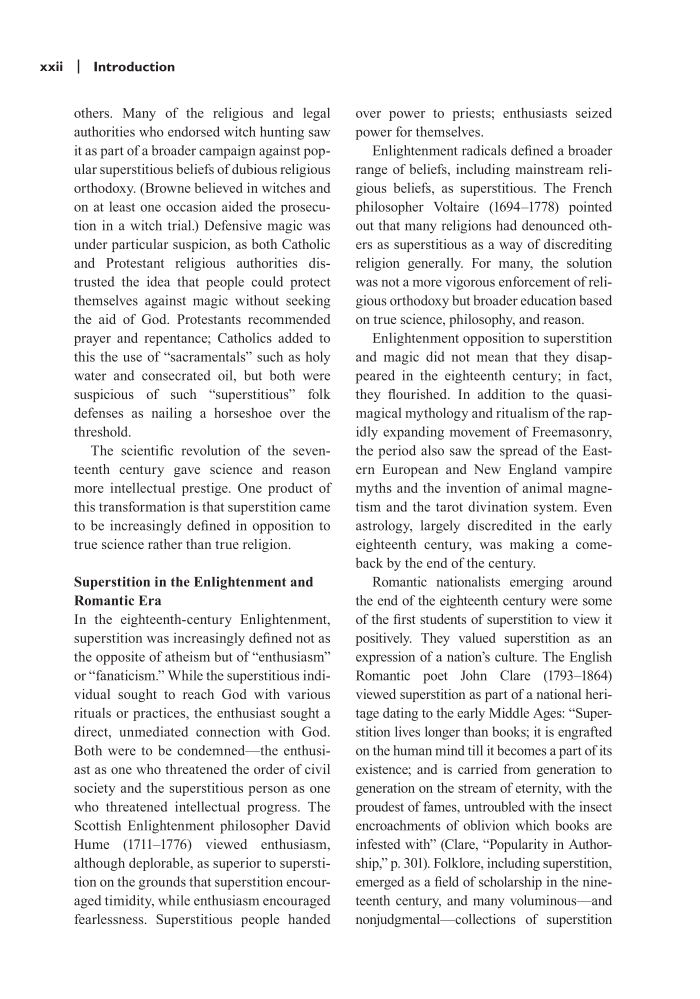Introduction xxii others. Many of the religious and legal authorities who endorsed witch hunting saw it as part of a broader campaign against pop- ular superstitious beliefs of dubious religious orthodoxy. (Browne believed in witches and on at least one occasion aided the prosecu- tion in a witch trial.) Defensive magic was under particular suspicion, as both Catholic and Protestant religious authorities dis- trusted the idea that people could protect themselves against magic without seeking the aid of God. Protestants recommended prayer and repentance Catholics added to this the use of “sacramentals” such as holy water and consecrated oil, but both were suspicious of such “superstitious” folk defenses as nailing a horseshoe over the threshold. The scientific revolution of the seven- teenth century gave science and reason more intellectual prestige. One product of this transformation is that superstition came to be increasingly defined in opposition to true science rather than true religion. Superstition in the Enlightenment and Romantic Era In the eighteenth-century Enlightenment, superstition was increasingly defined not as the opposite of atheism but of “enthusiasm” or “fanaticism.” While the superstitious indi- vidual sought to reach God with various rituals or practices, the enthusiast sought a direct, unmediated connection with God. Both were to be condemned—the enthusi- ast as one who threatened the order of civil society and the superstitious person as one who threatened intellectual progress. The Scottish Enlightenment philosopher David Hume (1711–1776) viewed enthusiasm, although deplorable, as superior to supersti- tion on the grounds that superstition encour- aged timidity, while enthusiasm encouraged fearlessness. Superstitious people handed over power to priests enthusiasts seized power for themselves. Enlightenment radicals defined a broader range of beliefs, including mainstream reli- gious beliefs, as superstitious. The French philosopher Voltaire (1694–1778) pointed out that many religions had denounced oth- ers as superstitious as a way of discrediting religion generally. For many, the solution was not a more vigorous enforcement of reli- gious orthodoxy but broader education based on true science, philosophy, and reason. Enlightenment opposition to superstition and magic did not mean that they disap- peared in the eighteenth century in fact, they flourished. In addition to the quasi- magical mythology and ritualism of the rap- idly expanding movement of Freemasonry, the period also saw the spread of the East- ern European and New England vampire myths and the invention of animal magne- tism and the tarot divination system. Even astrology, largely discredited in the early eighteenth century, was making a come- back by the end of the century. Romantic nationalists emerging around the end of the eighteenth century were some of the first students of superstition to view it positively. They valued superstition as an expression of a nation’s culture. The English Romantic poet John Clare (1793–1864) viewed superstition as part of a national heri- tage dating to the early Middle Ages: “Super- stition lives longer than books it is engrafted on the human mind till it becomes a part of its existence and is carried from generation to generation on the stream of eternity, with the proudest of fames, untroubled with the insect encroachments of oblivion which books are infested with” (Clare, “Popularity in Author- ship,” p. 301). Folklore, including superstition, emerged as a field of scholarship in the nine- teenth century, and many voluminous—and nonjudgmental—collections of superstition
Document Details My Account Print multiple pages
Print
You have printed 0 times in the last 24 hours.
Your print count will reset on at .
You may print 0 more time(s) before then.
You may print a maximum of 0 pages at a time.



































































































































































































































































































































